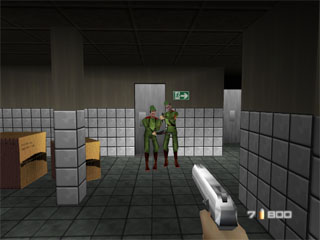Overview
Artificial intelligence in video games is not the real academic view of A.I. Game A.I. consists of scripted data driven algorithms that have predetermined data entering the system causing scripted responses in a controlled world. Video game A.I. is not about intelligence, it's about creating a realistic and fun experience. That said, game A.I. has matured into one of the pillars of modern game development. The quality of the A.I. can make or break a game.
A Brief History
 Goldeneye's AI Baddies
Goldeneye's AI BaddiesThe earliest video games were two-player games and thus usually lacked enemy AI, but this began changing with the release of Space Invaders, which featured enemies that move in formation and fire randomly, gradually increase speed and difficulty, and had distinct movement patterns. Galaxian added more complex and varied enemy movements, including maneuvers by individual enemies who break out of formation. Pac-Man showcased a much improved A.I. which consisted of four A.I. ghosts, each with unique personalities and different behaviors.
The stealth game Metal Gear featured a more sophisticated enemy AI, where enemies could hear gunshots from non-silenced weapons and would chase Solid Snake when the security alarm went off. Metal Gear 2: Solid Snake had a significantly improved AI, where enemies could hear footsteps, have a 45-degree field of vision, move their heads left and right, and behave in a more sophisticated manner when searching for intruders. The light-gun shooter Virtua Cop featured enemies who can duck and even dive when being shot at.
Early FPS A.I. in games like Doom and Wolfenstein 3D consisted of NPC's that would either walk toward the player with guns blazing or stay at their post as they shot at the player. Goldeneye 007 for the N64 is a good example of A.I.'s evolution in the genre. Like Virtua Cop, the NPCs would duck and dive when being shot at. They would also throw grenades to flush the player out, and blind-fire when out of range. The issue was that the NPCs knew the player's location at all times, even if the player was out of the line of sight. The NPCs were programmed to play blind until the character crosses this line.
A significant evolution was Metal Gear Solid 2: Sons of Liberty, which featured a squad-based collective AI, where unlike previous games, the enemy guards work together in squads. This included communicating with one another, both in person and through radio, and working together to out-flank Snake or Raiden. They are also able to detect lights and shadows, and react in a more realistic manner towards the player, such as showing fear when held at gunpoint. The enemies could also take cover as well as blind fire and throw grenades from cover.
Game A.I. has improved considerably in this modern era, but A.I. exploits still exist in most games today.
In some games, especially RPGs, the AI of characters can be customized. This was first introduced by Dragon Quest IV, where its "Tactics" system can adjust the AI routines of non-player characters during battle. This was later extended to player characters in games like Dragon Knight III, Dragon Quest V, and Phantasy Star IV. This concept was also extended to action RPGs by Secret of Mana, which applied user-adjustable AI routines in real-time, as was later the case with the Tales and Star Ocean games. Final Fantasy XII introduced the use of AI scripts, or gambits, which allows more flexibility when customizing the AI, with similar systems later seen in the Dragon Age games and Xenoblade Chronicles.
Types of Game A.I.
Scripting - Without question the most used game A.I. used to day. Think of it as an "If... then..." statement. If the player ducks behind a wall, wait four seconds and throw a grenade.
Random Scripting - A type of scripting that adds more variety to gameplay. Think "If... then... or..." If the player ducks behind a wall, wait four seconds and throw a grenade, or rush the wall guns blazing, or find higher ground and cover to shoot over the wall."
Behavioral or Character Based Scripting - Random scripting with character types. If a soldier NPC is deemed defensive its likelihood of doing a particular action could be tweaked as 25% of grenade attacks, 5% of rushing, 70% of taking cover. If the NPC is aggressive, 40 % grenade attaches, 45% of rushing, 20% of taking cover. Character based scripting is often adjusted throughout game balancing.
Situational Awareness - An advanced trait of A.I. scripting that improves a player's sense of immersion. By making scripted actions appear more dynamic and realistic, it adds a dimension of believability. Examples may be subtle effects like brushing a hand along a wall while walking past it, or more complex problem-solving behaviors like an NPC escaping from a trap set by the player using objects in the game environment.
Pathfinding - Getting an NPC from point A to B. 3D terrain and cover are huge A.I. dilemmas in modern A.I. programming. You also have to keep in account where the player is, is he firing, should the NPC fire when he moves, or go as fast as possible. Then at the end, did that look real. Scripting tells the NPC where "B" is Pathfinding gets him there.
Emergent - Where the game actually learns from your actions. Black & White and Nintendogs are good examples (although Nintendogs is pretty scripted).
Rubber Banding - Is a nickname A.I. that's used to boost the competitive feel of the game. In a racing game when the A.I. is slipping behind, the NPC driver receives speed boosts and better handling unavailable to the player to remain competitive. It increases tension. Burnout and Mario Kart both use rubber banding in races to keep them competitive. This is not exclusive to driving games. It's used in many sports games or skill based games.
Log in to comment